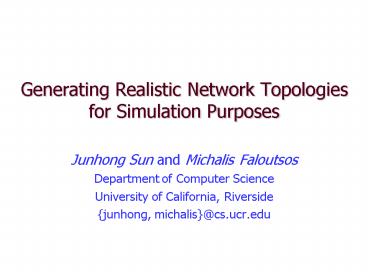Generating Realistic Network Topologies for Simulation Purposes
1 / 15
Title:
Generating Realistic Network Topologies for Simulation Purposes
Description:
Real Internet topology instances are huge. Most topology generators can't create ... Performance consistence: Running 50 times with different random seeds ... –
Number of Views:63
Avg rating:3.0/5.0
Title: Generating Realistic Network Topologies for Simulation Purposes
1
Generating Realistic Network Topologies for
Simulation Purposes
- Junhong Sun and Michalis Faloutsos
- Department of Computer Science
- University of California, Riverside
- junhong, michalis_at_cs.ucr.edu
2
Motivation
- Most network simulations are computationally
intensive. - Needs small and realistic topology models.
- Real Internet topology instances are huge.
- Most topology generators cant create realistic
topologies, and the synthesized graphs exhibit
the absence of some important topological
properties.
3
Our Approach
- We start from a large real topology, and reduce
it repeatedly until it reaches the desired size. - A set of topological metrics is used to validate
the realism of the reduced graphs. - We propose two algorithms
- Iterative Reduction Algorithm uses a
user-specified method to reduce a graph
repeatedly. - Combined Reduction Algorithm combines different
methods to achieve enhanced performance.
4
Topological Metrics
- Average out-degree
- Out-degree distribution
- C1 degree ?28 C2 degree 10-27
- C3 degree 4-9 C4 degree 1-3
- Power-Law 1
- out-degree vs. rank
- Power-Law 2
- number of nodes vs. out-degree
- Theyre invariant over time and we use them to
validate the realism of the reduced graphs.
5
Graph Reduction Methods
- Removal of nodes or edges
- Random Vertex Deletion (RVD)
- Random Edge Deletion (RED)
- Merging/Clustering of nodes
- Edge Shrinking (SRK) shrinks an edge into a node
- Clustering (CLST) merges neighbors of u and u
itself into one node - Induced subgraphs
- Subgraph by BFS (BFS) extracts a subgraph by BFS
- Subgraph by DFS (DFS) extracts a subgraph by DFS
6
Iterative Reduction Algorithm
STOP
Yes
No
Measure topological metrics of the reduced graph
Reduce a small percent of G using method M
Real topology G
Choose a method M
Desired Size
Method Pool
7
Our Approach Works
- Performance consistence
- Running 50 times with different random seeds
- Running on multiple instances of different sizes
- 67 of the original graph is removed, and 3 is
deleted in each iteration. - All methods show consistent performance.
- Random Edge Deletion shows the best performance
- Clustering performs less satisfactorily
- Topological properties are approximately kept.
8
Power-Laws are Preserved
- In most cases, power-law properties are preserved
during the reduction process
9
We Can Still Improve It
- Repeatedly applying the same method on the graph
works. - Out-degree distribution and power-laws are
invariant, but our methods change them slightly. - We have a diversified method pool. It is possible
to generate better results by combining them - Selects a different method to correct the
negative effects brought by methods in the
previous iterations.
10
Combined Reduction Algorithm
Real topology G
Randomly choose an initial method M
Desired Size
Method Pool
11
How to Choose a Method?
- Metric target models are extracted from
variations of those metrics of the real Internet
topology. - slope represents the effect of a method on this
metric.
- The method that has the smallest overall
predicted deviation is selected for the next
iteration.
12
Combined Algorithm is Better
13
Discussion
- We compare the combined algorithm and the
iterative algorithm using RED. - The combined algorithm shows the capability to
correct metric deviations during the reduction
process. - The generated small graphs have the desired
topological properties. - When a large percentage of the original graph is
removed, the combined algorithm shows better
performance.
14
The Significance of Our Approach
- We follow the opposite direction from commonly
used graph generators. - By reducing from large real topology, we can
generate small graphs with desired topological
properties. - Our approach could potentially preserve some
unknown properties of the Internet. - The small graphs generated by our approach are
considered more realistic.
15
Future Works
- To validate the realism and usefulness of our
algorithms by running various simulations on both
the original topology and on our generated small
graphs. - To incorporate some application-specific metrics
to generate graphs for intended use.































